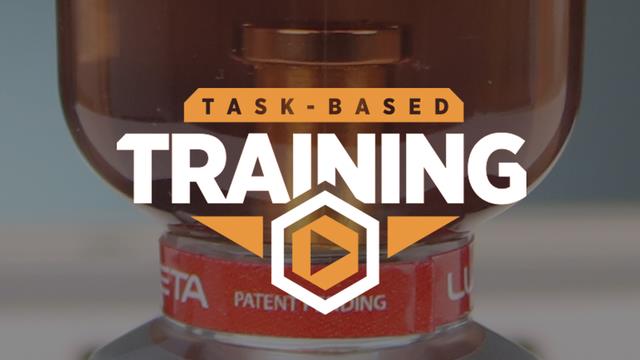
What is a BS&W bowl?
BS&W stands for bottom sediment and water. A BS&W bowl is a clear device installed on the bottom of a piece of equipment that provides a window into what is happening at the bottom of a reservoir. Heavy sediments, particulates, wear debris and free water become separated and trapped in the housing of the BS&W bowl, allowing for visual inspection.

Figure 1: A BS&W bowl.
Why use a BS&W bowl?
These devices allow us to detect early warning signs of impending machine or lubricant failures; the ability to see these things happening early on allows for mitigation of the problems before they get out of hand.
BS&W bowls also provide an ideal location to drain away accumulated water, flush the system out, and retrieve bottom samples.

Figure 2: Taking an oil sample with the BS&W bowl’s purge valve.
Why inspect a BS&W bowl?
The earlier we can catch a problem, the better chance we have of fixing it before failure occurs. Visual inspections of a BS&W bowl can reveal oil discoloration, cloudiness, and signs of oxidation. We can also look for water, particulates, dirt and debris (if a BS&W bowl is equipped with a magnet, we can also see the buildup of wear debris).

Figure 3: Sludgy buildup on the BS&W bowl’s magnet.
Where are they installed?
As the name suggests, BS&W bowls are installed at the bottom of the equipment. This allows the particulates that slowly settle in oil to build up in the bowl. It is also a good idea to add an isolation valve between the bowl and the equipment. This allows you to quickly cut off the oil to the bowl if it is leaking or other issues are occurring.
When do they need to be changed?
Anytime you inspect the BS&W bowl for oil conditions, you should also inspect the device itself. If any signs of damage are present (cracks, leaks, etc.), the bowl needs to be replaced. The glass of the bowl can also become stained over time, reducing visual access to the oil; stained bowls should also be replaced.

Figure 4: Discolored BS&W bowls.
Who inspects them?
Lube technicians are generally responsible for the BS&W bowl, but they’re easy to use, so anybody walking by the machine can perform a quick visual inspection.
Inspecting a BS&W bowl
Step 1: Clean the external surface of the bowl with a lint-free industrial towel. Use a flashlight or laser pointer to illuminate the fluid in the bowl.
Step 2: Inspect for contaminates. Look for undesirable free water, bottom sediment, or oil leaks. Also inspect the lubricant color for darkening.
Step 3: Purge any free water, sludge, or sediment, then clean the purge valve.

Figure 5: Draining a BS&W bowl.
Step 4: Report any abnormal conditions.
Key Takeaways
Always report anything abnormal.
Inspect BS&W bowls often.
Purge the BS&W bowl.
If possible, add an insolation valve.
BS&W bowls are prone to staining, and need to be replaced when this happens.




